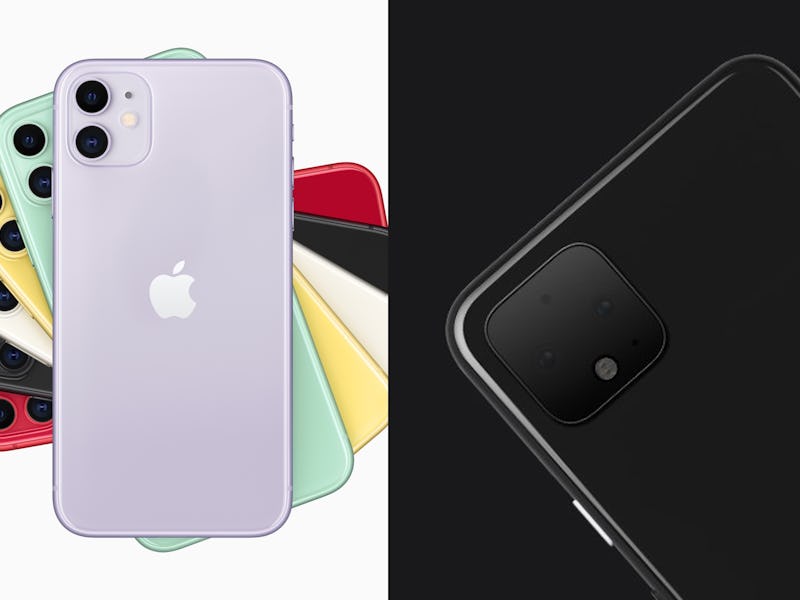iPhone 11 vs. Google Pixel 4: Price and Features for Dual-Lens Apple Phone
The battle for smartphone supremacy could start soon.

The iPhone 11 has arrived. On Tuesday, Apple took the wraps off its successor to the iPhone XR, a $699 dual-camera smartphone that offers faster speeds and better connectivity.
The new phone, set to hit stores on September 20, is set to turn heads as the company’s cheapest flagship in its latest three-device lineup. Like the iPhone XR, it maintains a 6.1-inch LCD screen, but now packs an extra camera lens, an A13 Bionic chip, and support for new features like Wi-Fi 6 and ultra-wideband location tracking.
But Apple may have stiff competition in the fight for the most eye-catching mainstream flagship. The Google Pixel 4 isn’t exactly official yet, but Google stunned onlookers in June when it confirmed the device was real and gave fans a sneak peek. The device is expected to receive a full unveiling sometime later this year, likely October based on the previous launches. Little is known about the device, bar a widely-anticipated radar-based gesture control system that looks like something out of a sci-fi film.
The iPhone remains one of the world’s key computing platforms. Last month, Apple products accounted for 22 percent of the global mobile devices in use around the world. iOS, the iPhone’s operating system, is used on 14 percent of all computing devices.
But although the iPhone maintains a stronghold, Android commands 40 percent of the global computing market, more than any other computing platform. Android developer Google holds great sway in the smartphone market, and the next release of the company’s flagship device is one of the biggest moments in the annual tech calendar.
Ahead of the Pixel 4’s launch, here’s how the two are set to compare.
The front of the iPhone 11.
Google Pixel 4 Vs. iPhone 11: Display
The iPhone 11 uses a 6.1-inch LCD screen with IPS technology. It has a resolution of 1,792 by 828 pixels to offer a resolution of 326 pixels per inch. It has a 1,400 to one contrast ratio, 625 nits of maximum brightness, and a “True Tone” display that adapts colors to their surroundings. Pressure-sensitive 3D Touch is gone, the same across the board.
The Pixel 4 is expected to feature a 5.7-inch display, possibly with a refresh rate of 90 Hz instead of the 60 Hz normally found on phones. A report from XDA-Developers suggests the devices could offer something similar to True Tone, adapting the colors to fit the surroundings. One rumor claims the resolution will show as 2,280 pixels by 1,080 pixels, which would result in a higher pixel density.
Google Pixel 4 Vs. iPhone 11: Camera
The iPhone 11 has a wide-angle lens with f/1.8 aperture and an ultra-wide angle lens with f/2.4 aperture, the latter offering a 120-degree field of view. Both lenses offer 12 megapixels. Software smarts enable advanced HDR, automatic red-eye correction, and portrait mode that blurs the background. The iPhone 11 also features Face ID like its predecessors, which enables depth-sensing background blur like the rear lenses. Slow-motion selfies, dubbed “slofies” by Apple, could prove a sleeper hit.
Night Mode, a newcomer to the iPhone range, could help Apple take on the Pixel in an area where historically Google has come out as king. Google, for what it’s worth, is rumored to be making its own improvements for the Pixel 4 launch. It may be a while before hands-on trials reveal which phone is superior.
Google is rumored to be including two cameras on the rear, a 12-megapixel sensor and a 16-megapixel telephoto sensor. One the front side, the Pixel 4 is expected to feature a front-facing camera with infrared sensor and flood illuminator for facial recognition. A Soli radar chip will enable hands-free gesture controls.
Google Pixel 4 Vs. iPhone 11: Internal Specifications
The iPhone 11 includes the A13 Bionic chip, dubbed by Apple as the fastest CPU and GPU in a smartphone in the world. Apple does not tend to share battery capacity specifications, but claims it will last up to one hour longer than the iPhone XR and support video playback of up to 17 hours.
The Google Pixel 4 is expected to use the Qualcomm Snapdragon 855 system-on-a-chip to power its internals. Pocket-Lint reports the 4 may include 6GB of RAM and a 2,800 mAh battery.
Google Pixel 4 Vs. iPhone 11: Price
Apple surprised viewers Tuesday when it announced the iPhone 11 would cost $699. That’s $50 less than the iPhone XR, and $300 less than the iPhone 11 Pro announced at the same event. The 64GB version costs $699, the 128GB version $749 and the 256GB version $849.
The Google Pixel 4 has no firm pricing. However, between the Pixel 2 and Pixel 3 Google raised the price by $150. The Google Pixel 3 retails for $799 for a 64GB version and $899 for a 128GB version. Its larger XL version is priced at $899 for the 64GB version and $999 for the 128GB version.
The battle for smartphone supremacy looks set to commence.